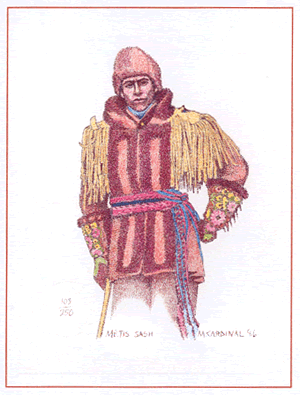
The Voyageurs
Between the 18th and the 19th centuries, some French Canadians where travelling around the Canada and the Upper Midwest of the United States to trade furs. Those courageous men were called the Voyageurs.
But they weren’t the first commercants in the challenging fur
trading business. A long time ago before them, there was coureur
des bois. Because of the fishing on the coast, they become the
people who first met with the Native Americans. They benefit of
the situation and began to trade some various European items for
furs with them (at this time, fur clothes was a must in Europe).
Little by little, they extend their era trading deeper into the
wilderness. Since the traders were traveling a lot more, the transportation of the furs became an important part in that business. But in 1681, the french gouvernement wanted to take in charge this new expanding livelihood. They created a system of licenses for fur traders, called congés, where each of them profit of 25 licenses per years. Those merchants became to be known as voyageurs and they transform the commerce into a legal and respectable business regulated. We can compare this to a modern situation: the taxi licenses. The voyageurs liken to the taxi, who needs an expensive license to do their job, and the courreur des bois liken to the Huber compagny, unregulated.
The task of the voyageurs was to transport and portage fur by canoe in order to commerce with the amerindiens. They were consider like legendaries and symbolized all the important values of the time, wich is courage and the spirit of adventure. One of the key explorers who left his mark on the New France’s history is La Vérendrye. He was the first voyageur to reach the region of present-day Winnipeg, and that fact earned him to be one of the greatest emblematic figures of Western Canada. He also reprensents the ideal voyageur, who walked long distances and discovered new waterways.
Rightly, an other unnamed ex voyageur said:
<< I could carry, paddle, walk and sing with any man I ever saw. I have been twenty-four years a canoe man, and forty-one years in service; no portage was ever too long for me, fifty songs could I sing. I have saved the lives of ten voyageurs, have had twelve wives and six running dogs. I spent all of my money in pleasure. Were I young again, I would spend my life the same way over. There is no life so happy as a voyageur's life! >>
Despite the fact that they were treated in heroes, their life was still one of the toughest. Indeed, that hard job wasn’t paid so much and most of the voyageurs worked fourty year long, with 16 to 18 hours of work a day. Sometimes canoeing through turbulent waters, sometines carrying load over 100 pounds from port to port, it’s not surprising that many men died prematurely from severe abdominal pulls.
In short, the voyageurs has played a big role in North America’s history and it will always be important to remember where do we come from.
References :
- https://en.wikipedia.org/wiki/Coureurs_des_bois#16811715:_The_Coureur_and_the_Voyageur
- https://en.wikipedia.org/wiki/Voyageurs
- http://www.members.shaw.ca/mno-ssm/metis-info/voyagurs.htm
- http://www.ameriquefrancaise.org/fr/article33/La_Vérendrye,_ou_l'archétype_du_voyageur_idéal.html#.VyNC9pXJ_IU



